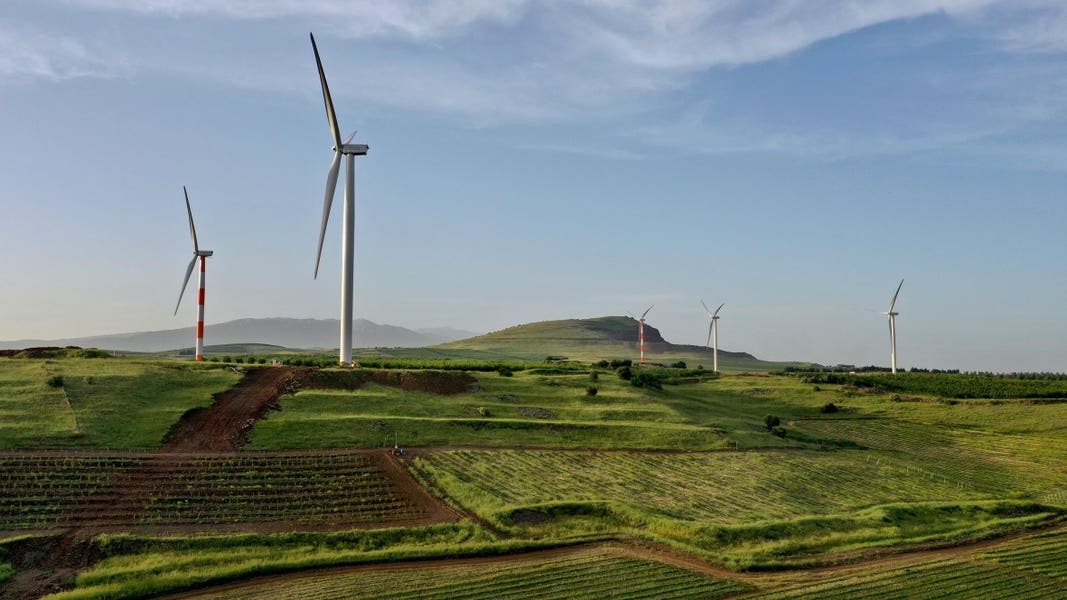EL ROM, GOLAN HEIGHTS – MAY 14: A late afternoon aerial view of new wind turbines constructed … [+] between vineyards and fruit orchards as part of the Valley of Tears (Emek Habacha) wind turbines farm project on May 14, 2020 near Kibbutz El Rom in Israel’s Golan Heights. The project is a joint venture of the Israeli company Enlight Renewable Energy Ltd which deals in solar and wind energy in Israel and Europe, Aveeram and Dr. Eli Ben Dov. The 34 General Electric turbines, which will generate a total installed capacity of 108 GW of sustainable energy, are sited on agricultural land of nearby five kibbutz farming communities and agricultural activity will continue concurrently with the operation of the turbines. The turbine’s hub height is about 86 meters above ground level, its three blades are 51.5 meters long and weigh some 17 metric tons each. The project is expected to come online in 2021 and at full capacity will supply environmentally friendly electricity to some 40,000 households in Israel, thereby reducing air pollution in Israel nearly 200,000 tons of carbon dioxide a year. (Photo by David Silverman/Getty Images)
Getty Images
“Druze protestors in the Golan Heights became violent in demonstrations against Israeli land policies.”
This headline could have led to innumerable articles and news stories over the years, but what happened on June 20 added another twist. This time, the Druze were protesting Israeli renewable energy projects that the Druze claim do not respect their historical land policies.
The Druze are an ancient sect whose religious practices are an amalgamation of Islamic, Christian, and other influences. Politically, they usually show loyalty to the country in which they live. Many Druze serve in the Israeli army, are among the most loyal soldiers, and rise to very high positions in the Israeli Defense Forces. By contrast, Druze in the disputed Golan Heights often retain their prior loyalty to countries like Syria, which controlled most of that territory prior to the 1967 Six Day War. Many have been in conflict with the Israeli government ever since.
At issue here is a project of the Israeli company Enlight Renewable Energy containing 39 General Electric wind turbines, each about 660 feet tall, known as “Genesis Wind.” When operational, the project is expected to supply 207 megawatts of electrical energy, enough to fill the yearly consumption of 70,000 households.
As the name Golan Heights obviously suggests, this region is very high in altitude, and it is the logical choice to host a windfarm.
That didn’t sit well, however, with the local Druze residents. They see the project as a threat to their historically agrarian lives and their ancestral homelands. This week they took to the streets, in a violent demonstration that seriously injured four Druze and also hurt twelve Israeli police. Feelings are so intense that some Druze leaders are claiming it could erupt into a full-fledged “Intifada’”, the term used by Palestinians to describe their violent demonstrations against Israeli authority.
Unlike natural gas or oil development, in which the drilling derrick is replaced after about 60 days with a much smaller structure, or solar panels which are fairly low to the ground generally, wind turbines can be huge structures that dominate the landscape. They can be visible from thousands of feet up in the air, and can be highly intimidating to look at from ground level. As such, they can be very disruptive to historical vistas and, in certain cases, long held religious beliefs about land. Adding to the controversy, in cases where land is disputed, as in the Middle East, those disruptions can lead to violence and even military conflict.
As existential of an issue climate change may be for the planet as a whole, this is a political reality that is vitally important for those demanding an immediate end to fossil fuels to understand. Solar panels and wind turbines obviously need to be placed in the locations where they can produce the most electricity , and it can then be most efficiently transmitted to every place that needs it. Even absent politics, this can sometimes be a scientifically or pragmatically difficult endeavor. However, adding political considerations to the matter makes things much more fraught. . Quite simply, in already volatile parts of the world, such as the Middle East, the best laid plans to combat climate change can cause actual wars.
More than anything else, the Druze demonstrations reinforce the fact that energy policy is always intertwined with politics, and that those who ignore that reality do so at their peril – regardless of how well-intentioned their energy plans may be. The Paris Climate Accords have been criticized for either not forcing developing countries to do enough, or else making them do too much. The Ukraine War highlighted how even the best of energy intentions can backfire in the face of political reality, and the current Middle East flareup shows how such good energy intentions can cause actual political upheaval, not to mention outright civil unrest and even violence. For the world to move forward and decarbonize to the extent scientifically possible, political reality must be looked at clearly and dealt with accordingly. It simply cannot be wished away.

